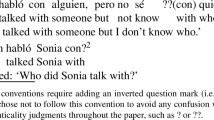Abstract
We describe two experiments that explored the on-line processing of coordinated (e.g.,The policeman defended himself and the fireman did [e] too, according to someone who was there) and subordinated VP-ellipsis (e.g.,The policeman defended himself because the fireman did [e], according to someone who was there). Such constructions have two possible interpretations: The “sloppy” reading is thatthe fireman defended himself, wherehimself corefers withthe fireman. The “strict” reading is thatthe fireman defended him, wherehim corefers withthe policeman. In our experiments we examined the strict reading, and found different time courses of processing the coordinated and subordinated structures. In coordination we found immediate reaccess of the nonlocal subject at the gap. In subordinated structures we found the reaccess effect only downstream from the gap. We interpret these patterns as reflecting the automatic nature of gap filling in coordinated ellipsis, but in subordinated ellipsis a causal relation must be computed between the two clauses, “drawing out” reaccess of the filler.
Similar content being viewed by others
References
Chomsky, N. (1986).Barriers. Cambridge, MA: MIT Press:
Dalrymple, M. (1991).Against reconstruction in ellipsis (Tech. Rep. No. SSL-91-114). Xerox.
Fiengo, R., & May, R. (1994).Indices and identity. Cambridge, MA: MIT Press.
Frazier, L. (1989). Against lexical generation of syntax. In W. Marslen-Wilson (Ed.),Lexical representation and process (pp. 505–528). Cambridge, MA: MIT Press.
Hestvik, A. (in press). Strict Reflexives.Natural Language Semantics.
Kehler, A. (1993). The effect of establishing coherence in ellipsis and anaphora resolution. InProceedings of the 31 st Conference of the Association for Computational Linguistics, Columbus, Ohio.
Kehler, A. (1994). Common topics and coherent situations: interpreting ellipsis in the context of discourse inference. InProceedings of the 32nd Conference of the Association for Computational Linguistics.
Kitagawa, Y. (1991). Copying identity,Natural Language and Linguistic Theory, 9, 497–536.
Levin, B. (1995).English verb classes and alternations. Chicago: University of Chicago Press.
Lobeck, A. (1992). Licensing and identification of ellipted categories in English, In S. Berman & A. Hestvik (Eds.),Proceedings of the Stuttgart Ellipsis Workshop, (Arbeitspapiere des Sonderforschungsbereich 340, Bericht Nr. 29-1992). Heidelberg: IBM Germany.
MacDonald, M. C., Pearlmutter, N. J., & Seidenberg, M. S. (1994). Lexical nature of syntactic ambiguity resolution.Psychological Review, 101, 676–703.
McKoon, G., & Ratcliff, R. (1994). Sentential context and on-line lexical decision.Journal of Experimental Psychology: Learning, Memory, and Cognition, 20, 1239–1243.
McKoon, G., Ratcliff, R., & Ward, G. (1994). Testing theories of language processing: An empirical investigation of the on-line lexical decision task.Journal of Experimental Psychology: Learning, Memory, and Cognition, 20, 1219–1228.
Nicol, J. (1988). Coreference processing during sentence comprehension. Unpublished doctoral dissertation, MIT, Cambridge, MA.
Nicol, J. L., Fodor, J. D., & Swinney, D. (1994). Using cross-modal lexical decision tasks to investigate sentence processing.Journal of Experimental Psychology: Learning, Memory, and Cognition, 20, 1229–1238.
Shapiro, L. P., Nagel, N., & Levine, B. A. (1993). Preferences for a verb's complements and their use in sentence processing.Journal of Memory and Language, 32, 96–114.
Swinney, D., Ford, M., & Bresnan, J. (1989). On the temporal course of gap-filling and antecedent assignment during sentence comprehension. In B. Grosz, R. Kaplan, M. Macken, & I. Sag (Eds.),Language structure and processing. Stanford, CA: CSLI.
Swinney, D., & Osterhout, L. (1991). Inference generation during language comprehension. In A. Graesser & G. H. Bower (Eds.),The psychology of learning and motivation: Inference and text comprehension, 25, New York: Academic Press.
Trueswell, J. C., Tanenhaus, M. K., & Kello, C. (1993). Verb-specific constraints in sentence processing: Separating effects of lexical preference from gardenpaths.Journal of Experimental Psychology: Learning, Memory, and Cognition, 19, 528–553.
Author information
Authors and Affiliations
Additional information
The research reported in this manuscript was supported by NIH grant DC00494 and by a University of Bergen Faculty of Arts research grant. We thank Andy Barss for his thoughtful review and suggestions, and Tom Bever, Andy Kehler, and Gregory Ward for their suggestions prior to and after our presentation at the 1995 CUNY Human Sentence Processing Conference. We also thank Kim Luscher and our research assistants for their invaluable contributions to this work.
Rights and permissions
About this article
Cite this article
Shapiro, L.P., Hestvik, A. On-line comprehension of VP-ellipsis: Syntactic reconstruction and semantic influence. J Psycholinguist Res 24, 517–532 (1995). https://doi.org/10.1007/BF02143165
Accepted:
Issue Date:
DOI: https://doi.org/10.1007/BF02143165




